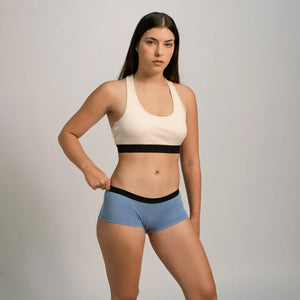Trends and Perspectives that The Pandemic Left in
The Fashion Industry
AYA | DECEMBER 13, 2024
READING TIME: 7 minutes
The fashion industry has undergone a major transformation in recent years, driven by a global shift in consumer behaviors. As lifestyles and priorities evolved, so did the ways in which people approached clothing shopping. This article delves into the notable changes in clothing purchasing behavior observed during and after this pandemic period, one of the most significant global shifts in recent decades, drawing upon statistics and insights from leading research.
Shift in Consumer Priorities
As lockdowns began globally in early 2020, many consumers shifted their priorities. According to McKinsey's "The State of Fashion 2020", the pandemic prompted a reevaluation of consumer values, with sustainability, health, and wellness taking center stage [1]. For example, a survey of international fashion executives and experts revealed that 67% of respondents had changed their purchasing behavior to favor brands that promote sustainability and ethical practices [1,2] . This shift reflects a broader trend where consumers are increasingly considering the environmental impact of their purchases.
Additionally, with many people working from home, the demand for formal and business attire plummeted. In contrast, casual wear, loungewear, and athleisure surged in populary. A report from Edited noted that searches for loungewear increased by 140% during the early months of the pandemic, indicating a significant pivot in consumer preferences [3].
E-Commerce Boom
The pandemic accelerated the growth of e-commerce in the fashion sector. According to a report by Statista, global online fashion sales reached $600 billion in 2021, a significant increase from previous years [4]. Consumers who once preferred physical stores turned to online platforms, leading to an increase in digital engagement.
In a survey by the National Retail Federation, 47% of consumers reported shopping online more frequently during the pandemic than they did before [5]. This shift not only impacted established retailers but also provided a platform for smaller, independent brands to reach consumers directly [6]. Brands that invested in their online presence found themselves in a better position to thrive amidst the changing landscape.
.
The Role of Social Media
Social media played a crucial role in influencing consumer behavior during the pandemic. With people spending more time online, platforms like Instagram and TikTok became pivotal for brands to connect with consumers. Influencer marketing experienced a resurgence as users looked to their favorite personalities for fashion inspiration, with 75% of consumers discovering new brands through social media during this time [1,2].
Furthermore, social media facilitated the rise of “social shopping”, where consumers could purchase items directly through posts and advertisements. This integration of e-commerce into social platforms provided a seamless shopping experience, further driving online sales.

Changing Demographics and Preferences
The pandemic also highlighted shifting demographics in the fashion market. Younger consumers, particularly Gen Z and Millennials, became increasingly influential in shaping purchasing trends. Research from the Institute for Sustainable Fashion indicates that younger generations are more likely to support sustainable brands, with 83% of Millennials stating they prefer to buy from companies that share their values [7,8].
Moreover, with the rise of remote work, many consumers reported a preference for comfort over style. A study published in the Journal of Fashion Marketing and Management noted that comfort became the primary driver of clothing purchases for many consumers, with 65% prioritizing comfort in their buying decisions [9]. This trend is likely to persist as remote work becomes a more permanent aspect of many industries.

Changing Demographics and Preferences
The pandemic also highlighted shifting demographics in the fashion market. Younger consumers, particularly Gen Z and Millennials, became increasingly influential in shaping purchasing trends. Research from the Institute for Sustainable Fashion indicates that younger generations are more likely to support sustainable brands, with 83% of Millennials stating they prefer to buy from companies that share their values [7,8].
Moreover, with the rise of remote work, many consumers reported a preference for comfort over style. A study published in the Journal of Fashion Marketing and Management noted that comfort became the primary driver of clothing purchases for many consumers, with 65% prioritizing comfort in their buying decisions [9]. This trend is likely to persist as remote work becomes a more permanent aspect of many industries.

The Aftermath: Permanent Changes in Consumer Behavior
Almost three years after the world emerged from lockdown, several of these changes appear to be lasting. While there has been a return to physical stores, the convenience of online shopping continues to influence consumer habits: 70% of consumers said they would continue to shop online more than before the pandemic [6], even when stores reopen.
Additionally, brands have adapted their strategies to focus on sustainability, inclusivity, and digital engagement. Many retailers have implemented more robust online platforms, improved their supply chain transparency, and focused on offering diverse sizing and styles to cater to a broader audience.

The Future of Fashion Retail
Looking ahead, the fashion industry must continue to evolve to meet the changing demands of consumers. Brands will need to embrace sustainability, prioritize comfort, and enhance their digital presence to remain competitive [10]. The shift towards a more ethical fashion system: “It’s Time to Rewire the Fashion System”, suggests that the industry must adopt new frameworks for production and consumption to better align with consumer expectations [1,2].
Moreover, integrating technology into the shopping experience—such as augmented reality and personalized shopping experiences—could play a crucial role in attracting consumers who now have heightened expectations for convenience and engagement.
So, one of the main novelties that the pandemic left us was the great push for casual wear, loungewear and athleisure to no longer be niche clothing lines, but to be used for more and more activities. Now, what will the increased demand for this type of clothing mean?
Glossarykeywords
Athleisure:
It refers to clothing lines that fuse the "athletic" and "leisure" styles and that allow you to do your daily activities with more versatility than usual.
Casual wear:
Refers to a type of casual, comfortable and sophisticated clothing that is worn in contexts where spontaneity reigns because they do not require a formal dress code.
Ethical practices:
They are actions that combine values and character to create a positive impact on life.
Gen Z:
Also known as "centennials", it is the generation of people born between 1997 and 2010.
Loungewear:
It refers to clothing that can be used for moments of relaxation or rest, clothing that is functional and comfortable at the same time.
Millennials:
It is the generation of people born between 1981 and 1996.
Purchasing behavior:
It is the study of how customers/users behave when making a decision regarding a purchase.
Glossarykeywords
Athleisure:
It refers to clothing lines that fuse the "athletic" and "leisure" styles and that allow you to do your daily activities with more versatility than usual.
Casual wear:
Refers to a type of casual, comfortable and sophisticated clothing that is worn in contexts where spontaneity reigns because they do not require a formal dress code.
Ethical practices:
They are actions that combine values and character to create a positive impact on life.
Gen Z:
Also known as "centennials", it is the generation of people born between 1997 and 2010.
Loungewear:
It refers to clothing that can be used for moments of relaxation or rest, clothing that is functional and comfortable at the same time.
Millennials:
It is the generation of people born between 1981 and 1996.
Purchasing behavior:
It is the study of how customers/users behave when making a decision regarding a purchase.
References:
[1] Amed I, Balchandani A, Barrelet D, Berg A, D’Auria G, Rölkens F, et al. The state of fashion 2024: Finding pockets of growth as uncertainty reigns. McKinsey; 2024. Available from: https://www.mckinsey.com/industries/retail/our-insights/state-of-fashion-report-archive-2017-2024 [Accessed 6 December 2024].
[2] Amed, I., Balchandani, A., Barrelet, D., Berg, A., D’Auria, G., Rölkens, F., ... & Woetzel, J. R. The State of Fashion 2020: Navigating uncertainty. New York: McKinsey & Company; 2020.
[3] BBC News. Omicron dampens Christmas sales as shoppers swap party clothes for loungewear [Online]. 2021 [Accessed 2024-12-12]. Available from: https://www.bbc.com/news/business-59945035
[4] Statista Research Department. Fashion E-commerce Worldwide - Statistics & Facts [Internet]. Statista; 2024 [cited 2024 Dec 12]. Available from: https://www.statista.com/topics/9288/fashion-e-commerce-worldwide/#topicOverview
[5] National Retail Federation (NRF). Consumers Want It All: Customer experience is key to growth in the new era of retail. Washington, DC: NRF; 2022.
[6] Morgan, E. The pandemic led to a resurgence of independent retail [Internet]. Fast Company. 2023 [cited 2024 Dec 12]. Available from: https://www.fastcompany.com/90881131/the-pandemic-led-to-a-resurgence-of-independent-retail
[7] Istituto Marangoni Miami. Fashion Trends 2021: The Year of Sustainability [Internet]. Istituto Marangoni Miami; 2021 [cited 2024 Dec 12]. Available from: https://www.istitutomarangonimiami.com/blog/fashion-trends-2021-the-year-of-sustainability/
[8] Amed, I., Balchandani, A., Barrelet, D., Berg, A., D’Auria, G., Rölkens, F., ... & Woetzel, J. R. The State of Fashion 2021. New York: McKinsey & Company; 2021.
[9] Mandarić, D., Hunjet, A., & Vuković, D. The Impact of Fashion Brand Sustainability on Consumer Purchasing Decisions. Journal of Risk and Financial Management. 2022;15(4):176. https://doi.org/10.3390/jrfm15040176
[10] Winn, J. Why sustainability is crucial for corporate strategy [Internet]. World Economic Forum; 2022 Jun 21 [cited 2024 Dec 12]. Available from: https://www.weforum.org/stories/2022/06/why-sustainability-is-crucial-for-corporate-strategy/
You don't have to put all the weight on your shoulders. Every action counts. At AYA, we fight microplastic pollution by making a 100% plastic-free catalog.
Visit Our Shop →You May Also Like to Read...
Paris Fashion Week 2025: Can Sustainable Fashion Replace Glamour?
Explore the environmental impact of Paris Fashion Week 2025, from carbon footprints to textile waste. Are luxury brands balancing glamour with eco-friendly practices?
Sustainable Fashion Insights for World Environment Day
Discover how sustainable fashion—using organic cotton, natural dyes, and local production—is shaping a regenerative future for World Environment Day.
The Health Risks of Synthetic Fibers & Microplastics
Explore the health impacts of synthetic fibers—respiratory damage, gut disruption, and hormonal imbalance—and how to switch to safe, natural alternatives.
Fast Fashion and Biodiversity Loss
Fast fashion is accelerating ecosystem destruction, from deforestation to ocean pollution. Discover how this industry is contributing to global biodiversity loss.


















